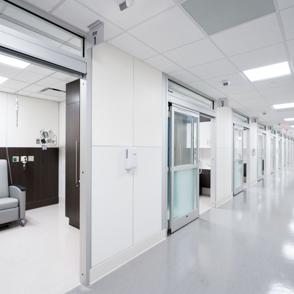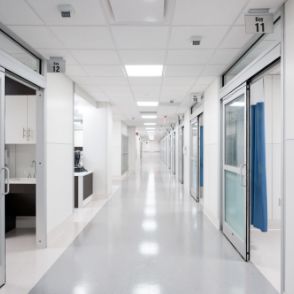Sustainable prefab interiors are flipping the traditional construction model by providing a solution that adheres to energy-efficiency requirements while also reducing environmental impact.
As a result, sustainable prefab interiors are becoming an essential, cost-effective and efficient solution for healthcare spaces and commercial construction.
This method reduces the issues in traditional construction, including excessive material waste, high energy consumption and environmental damage caused by on-site building procedures.
The Role of Sustainable Materials in Prefab Interiors
Sustainable prefab interiors focus on the use of eco-friendly materials. Prefabrication focuses on solutions that are durable, sustainable and have a lower or non-existent environmental effect.
In our solutions, we also used recycled denim as insulation.
Energy Efficiency in Sustainable Prefab Interiors
Prefab’s off-site manufacturing process offers more control over energy use. In manufacturing, energy may be controlled more effectively, meaning less waste. This is in sharp contrast to a typical on-site building, where the amount of energy used is frequently unpredictable and impossible to optimise.
In the long term, the energy efficiency you find on prefab interiors not only decreases operational costs but also dramatically reduces environmental effect.
Waste Reduction and Resource Management
Prefab models benefit from precise cutting and assembly throughout the production process, reducing offcuts and ensuring that materials are used to their maximum capacity. Any extra components are often reused or recycled, contributing to the process’s overall environmental impact.
Furthermore, because prefabricated components are manufactured at a factory and then brought to the assembly site, there is less need for on-site material storage, which frequently results in damage and waste.
The Long-Term Environmental Benefits of Sustainable Prefab Construction
Our prefab interiors are built to be durable, adaptable and energy efficient. Their versatility enables simple alterations or expansions as requirements change, eliminating the need for additional materials and cutting energy use.
Prefab interiors frequently require fewer renovations, which reduces their environmental effect. This combination of durability, flexibility and minimal maintenance makes sustainable prefab interiors an attractive solution for lowering environmental footprints while retaining high-quality facilities.
The Future of Interior Construction
Sustainable prefabrication is altering the building industry by providing an ecologically responsible and economically feasible solution. Prefab interiors solve some of the most severe environmental concerns confronting the construction industry today by prioritising the use of sustainable materials, increasing energy efficiency and significantly decreasing waste.
As demand for green building solutions grows, sustainable prefabrication is poised to play a key role in determining the industry’s future. Whether for health or commercial, prefabrication provides a road ahead that respects sustainability principles while producing high-quality, flexible spaces.
For more information on how sustainable prefab interiors can benefit your next project, get in touch today.






Sorry, the comment form is closed at this time.